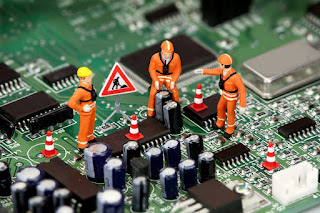Computer Hardware
What is computer ?
It is Common Operated Machine Prepared to use for Trade Education and Research It is also called a Programmable Machine
It is fully Electronical Machine and Digital
History
In its most basic form a computer is any device which aids humans in performing various kinds of computations or calculations.
In that respect the earliest computer was the abacus, used to perform basic arithmetic operations. Every computer supports some form of input, processing, and output.
 This is less obvious on a primitive device such as the
abacus where input, output and processing are simply
the act of moving the pebbles into new positions, seeing
the changed positions, and counting. Regardless, this is
what computing is all about, in a nutshell.
This is less obvious on a primitive device such as the
abacus where input, output and processing are simply
the act of moving the pebbles into new positions, seeing
the changed positions, and counting. Regardless, this is
what computing is all about, in a nutshell.We input information, the computer processes it according to its basic logic or the program currently running, and outputs the results. Modern computers do this electronically, which enables them to perform a vastly greater number of calculations or computations in less time. Despite the fact that we currently use computers to process images, sound, text and other non-numerical forms of data, all of it depends on nothing more than basic numerical calculations. Graphics, sound etc. are merely abstractions of the numbers being crunched within the machine; in digital computers these are the ones and zeros, representing electrical on and off states, and endless combinations of those. In other words every image, every sound, and every word have a corresponding binary code. Meaning primitive :
Belonging to an early stage of technical development Abstractions A concept or idea not associated with any specific instance ("he loved her only in the abstraction--not in person")
While abacus may have technically been the first computer most people today associate the word “computer” with electronic computers which were invented in the last century, and have evolved into modern computers we know of today. First Generation Computers (1940s – 1950s) First electronic computers used vacuum tubes, and they were huge and complex.

The first general purpose electronic computer was the ENIAC (Electronic Numerical Integrator And Computer) It was digital, although it didn’t operate with binary code, and was reprogrammable to solve a complete range of computing problems. It was programmed using plugboards and switches, supporting input from an IBM card reader, and output to an IBM card punch. It took up 167 square meters, weighed 27 tons, and consuming 150 kilowatts of power. It used thousands of vacuum tubes, crystal diodes, relays, resistors, and capacitors. The first non-general purpose computer was ABC (Atanasoff–Berry Computer), and other similar computers of this era included german Z3, ten British Colossus computers, LEO, Harvard Mark I, and UNIVAC

Second Generation Computers (1955 – 1960)
The second generation of computers came about thanks to the invention of the transistor, which then started replacing vacuum tubes in computer design. Transistor computers consumed far less power, produced far less heat, and were much smaller compared to the first generation, albeit still big by today’s standards.The first transistor computer was created at the University of Manchester in 1953. The most popular of transistor computers was IBM 1401. IBM also created the first disk drive in 1956, the IBM 350 RAMAC.

Third Generation Computers (1960s)
IBM System/360 The invention of the integrated circuits (ICs), also known as microchips, paved the way for computers as we know them today.
Making circuits out of single pieces of silicon, which is a semiconductor, allowed them to be much smaller and more practical to produce. This also started the ongoing process of integrating an ever larger number of transistors onto a single microchip. During the sixties microchips started making their way into computers, but the process was gradual, and second generation of computers still held on. First appeared minicomputers, first of which were still based on non-microchip transistors, and later versions of which were hybrids, being based on both transistors and microchips, such as IBM’s System/360.
They were much smaller, and cheaper than first and second generation of computers, also known as mainframes. Minicomputers can be seen as a bridge between mainframes and microcomputers, which came later as the proliferation of microchips in computers grew.
Fourth Generation Computers (1971 – present)
First microchips-based central processing units consisted of multiple microchips for different CPU components. The drive for ever greater integration and miniaturization led towards single-chip CPUs, where all of the necessary CPU components were put onto a single microchip, called a microprocessor. The first single-chip CPU, or a microprocessor, was Intel 4004. The advent of the microprocessor spawned the evolution of the microcomputers, the kind that would eventually become personal computers that we are familiar with today.
Components of Computer Hardware ---------------------------Software Hardware
The Physical parts of the computer which we can touch“ Wires, transistors, circuits is called Hardware
Software Software is defime as a set of instruction which is given to the hardware to perform a specific process to get an desired output

Comments
Post a Comment